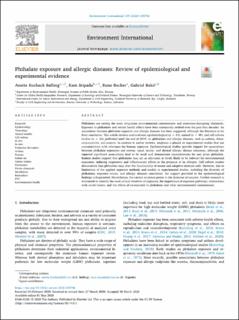| dc.description.abstract | Phthalates are among the most ubiquitous environmental contaminants and endocrine-disrupting chemicals. Exposure to phthalates and related health effects have been extensively studied over the past four decades. An association between phthalate exposure and allergic diseases has been suggested, although the literature is far from conclusive. This article reviews and evaluates epidemiological (n = 43), animal (n = 49), and cell culture studies (n = 42), published until the end of 2019, on phthalates and allergic diseases, such as asthma, rhinoconjunctivitis, and eczema. In contrast to earlier reviews, emphasis is placed on experimental studies that use concentrations with relevance for human exposure. Epidemiological studies provide support for associations between phthalate exposures and airway, nasal, ocular, and dermal allergic disease outcomes, although the reported significant associations tend to be weak and demonstrate inconsistencies for any given phthalate. Rodent studies support that phthalates may act as adjuvants at levels likely to be relevant for environmental exposures, inducing respiratory and inflammatory effects in the presence of an allergen. Cell culture studies demonstrate that phthalates may alter the functionality of innate and adaptive immune cells. However, due to limitations of the applied exposure methods and models in experimental studies, including the diversity of phthalates, exposure routes, and allergic diseases considered, the support provided to the epidemiological findings is fragmented. Nevertheless, the current evidence points in the direction of concern. Further research is warranted to identify the most critical windows of exposure, the importance of exposure pathways, interactions with social factors, and the effects of co-exposure to phthalates and other environmental contaminants. | en_US |

